Dexamethasone-Loaded, PEGylated, Vertically Aligned, Multiwalled Carbon Nanotubes for Potential Ischemic Stroke Intervention
Abstract
1. Introduction
2. Results and Discussion
2.1. Location of the Substrate, Catalyst Concentration and Acid Purifiction of MWCNTs
2.2. Determination of Crystallinity, Thermal Properties and Raman Spectroscopy of MWCNTs
2.3. Effect of Synthesis Times and Gas Flow Rates on the Length and Diameter of MWCNTs
2.4. Mixture of Ferrocene/Nickelocene/Cobaltocene on MWCNT Growth
2.5. Porositometric and Particle Size Distribution Properties of MWCNTs
2.6. FTIR Spectroscopy and H1 NMR Analyses of PEGylated MWCNTs
2.7. Dexamethasone Loading to and Release from MWCNTs
2.8. Cytotoxicity Evaluation of the Functionalized Carbon Nanotubes
3. Materials and Methods
3.1. Synthesis of MWCNTs Using Chemical Vapor Deposition
3.2. Design and Optimization of Formulations Using a Design Strategy
3.3. Functionalization of MWCNTs
3.4. Morphological and Molecular Spectroscopic Evaluation of the MWCNTs
3.5. Thermogravimetric and Porositometric Analyses of MWCNTs
3.6. Particle Size, Zeta Potential, Crystallinity and Elemental Composition of MWCNTs
3.7. Dex and Dex-PEG-MWCNTs Preparations and Drug Release Studies
3.8. Cytotoxicity Evaluation of VA-MWCNTs
4. Conclusions
Author Contributions
Funding
Acknowledgments
Conflicts of Interest
References
- Komane, P.P.; Choonara, Y.E.; Du Toit, L.C.; Kumar, P.; Kondiah, P.P.D.; Modi, G.; Pillay, V. Diagnosis and treatment of neurological and ischemic disorders employing carbon nanotube technology. J. Nanomater. 2016, 2016. [Google Scholar] [CrossRef]
- Iijima, S. Helical microtubules of graphitic carbon. Nature 1991, 354, 56–58. [Google Scholar] [CrossRef]
- Lee, G.; Youk, J.H.; Lee, J.; Sul, I.H.; Yu, W.R. Low-temperature grafting of carbon nanotubes on carbon fibers using a bimetallic floating catalyst. Diam. Relat. Mater. 2016, 68, 118–126. [Google Scholar] [CrossRef]
- Lodhi, N.; Mehra, N.K.; Jain, N.K. Development and characterization of dexamethasone mesylate anchored on multi walled carbon nanotubes. J. Drug Target. 2013, 21, 67–76. [Google Scholar] [CrossRef] [PubMed]
- Roy, S.; David-Pur, M.; Hanein, Y. Carbon nanotube growth inhibition in floating catalyst. Carbon 2017, 116, 40–49. [Google Scholar] [CrossRef]
- Tewari, A.; Sharma, S.C. Effect of different carrier gases and their flow rates on the growth of carbon nanotubes. Phys. Plasmas 2015, 43501, 1–12. [Google Scholar] [CrossRef]
- Rahman, M.; Younes, H.; Ni, G.; Zhang, T.; Al, A. Synthesis and optical characterization of carbon nanotube arrays. Mater. Res. Bull. 2016, 77, 243–252. [Google Scholar] [CrossRef]
- Psarros, C.; Lee, R.; Margaritis, M.; Antoniades, C. Nanomedicine for the prevention, treatment and imaging of atherosclerosis. Nanomedicine 2012, 8 (Suppl. 1), S59–S68. [Google Scholar] [CrossRef] [PubMed]
- Veziri, C.M.; Pilatos, G.; Karanikolos, G.N.; Labropoulos, A.; Kordatos, K. Growth and optimization of carbon nanotubes in activated carbon by catalytic chemical vapor deposition. Micropor. Mesopor. Mat. 2008, 110, 41–50. [Google Scholar] [CrossRef]
- Allaedini, G.; Tasirini, S.; Aminayi, P.; Yaakob, Z.; Telib, M. Carbon nanotubes via different catalysts and the important factors that affect their production: A review on catalyst preferences. Int. J. Nano Dimens. 2016, 7, 186–200. [Google Scholar]
- Ghaharpour, F.; Bahari, A.; Abbasi, M.; Akbar, A. Parametric investigation of CNT deposition on cement by CVD process. Constr. Build. Mater. 2016, 113, 523–535. [Google Scholar] [CrossRef]
- Voge, C.M.; Johns, J.; Raghavan, M.; Morris, M.D.; Stegemann, J.P. Wrapping and dispersion of multiwalled carbon nanotubes improves electrical conductivity of protein-nanotube composite biomaterials. J. Biomed. Mater. Res. Part A 2013, 101 A, 231–238. [Google Scholar] [CrossRef] [PubMed]
- Khorrami, S.A.; Lotfi, R. Influence of carrier gas flow rate on carbon nanotubes growth by TCVD with Cu catalyst. J. Saudi Chem. Soc. 2016, 20, 432–436. [Google Scholar] [CrossRef]
- De Greef, N.; Zhang, L.; Magrez, A.; Forró, L.; Locquet, J.P.; Verpoest, I.; Seo, J.W. Direct growth of carbon nanotubes on carbon fibers: Effect of the CVD parameters on the degradation of mechanical properties of carbon fibers. Diam. Relat. Mater. 2015, 51, 39–48. [Google Scholar] [CrossRef]
- Acomb, J.C.; Wu, C.; Williams, P.T. The use of different metal catalysts for the simultaneous production of carbon nanotubes and hydrogen from pyrolysis of plastic feedstocks. Appl. Catal. B Environ. 2016, 180, 497–510. [Google Scholar] [CrossRef]
- Yuan, Y.; Lee, T.R. Contact Angle and Wetting Properties. In Surface Science Techniques; Bracco, G., Holst, B., Eds.; Springer: Berlin, Germany, 2013; p. 663. [Google Scholar]
- Zhao, Q.; Bi, J.; Wang, W.; Sun, G. A novel method of functionalizing carbon nanotubes via neutralization reaction. Mater. Lett. 2016, 185, 523–525. [Google Scholar] [CrossRef]
- Eaton, P.; Quaresma, P.; Soares, C.; Neves, C.; de Almeida, M.P.; Pereira, E.; West, P. A direct comparison of experimental methods to measure dimensions of synthetic nanoparticles. Ultramicroscopy 2017, 182, 179–190. [Google Scholar] [CrossRef] [PubMed]
- Razzazan, A.; Atyabi, F.; Kazemi, B.; Dinarvand, R. In vivo drug delivery of gemcitabine with PEGylated single-walled carbon nanotubes. Mater. Sci. Eng. C 2016, 62, 614–625. [Google Scholar] [CrossRef] [PubMed]
- Besley, N.A.; Noble, A. NMR chemical shifts of molecules encapsulated in single walled carbon nanotubes. J. Chem. Phys. 2008, 128. [Google Scholar] [CrossRef] [PubMed]
- Khorram, R.; Raissi, H.; Morsali, A. Assessment of solvent effects on the interaction of Carmustine drug with the pristine and COOH-functionalized single-walled carbon nanotubes: A DFT perspective. J. Mol. Liq. 2017, 240, 87–97. [Google Scholar] [CrossRef]
- Venditti, I.; Fontana, L.; Fratoddi, I.; Battocchio, C.; Cametti, C.; Sennato, S.; Mura, F.; Sciubba, F.; Delfini, M.; Vittoria, M. Direct interaction of hydrophilic gold nanoparticles with dexamethasone drug: Loading and release study. J. Colloid Interface Sci. 2014, 418, 52–60. [Google Scholar] [CrossRef] [PubMed]
- Roozbahani, M.; Kharaziha, M.; Emadi, R. pH sensitive dexamethasone encapsulated laponite nanoplatelets: Release mechanism and cytotoxicity. Int. J. Pharm. 2017, 518, 312–319. [Google Scholar] [CrossRef] [PubMed]
- Ketabi, S.; Rahmani, L. Carbon nanotube as a carrier in drug delivery system for carnosine dipeptide: A computer simulation study. Mater. Sci. Eng. C 2017, 73, 173–181. [Google Scholar] [CrossRef] [PubMed]
- Zeinabad, H.A.; Zarrabian, A.; Saboury, A.A.; Alizadeh, A.M.O.; Falahati, M. Interaction of single and multi wall carbon nanotubes with the biological systems: Tau protein and PC12 cells as targets. Sci. Rep. 2016, 6. [Google Scholar] [CrossRef]
- Gopinathan, J.; Quigley, A.F.; Bhattacharyya, A.; Padhye, R.; Kapsa, R.M.I.; Nayak, R.; Shanks, R.A.; Houshyar, S. Preparation, characterisation, and in vitro evaluation of electrically conducting poly(ε-caprolactone)-based nanocomposite scaffolds using PC12 cells. J. Biomed. Mater. Res. Part A 2016, 104, 853–865. [Google Scholar] [CrossRef] [PubMed]
- Zare-Zardini, H.; Amiri, A.; Shanbedi, M.; Taheri-Kafrani, A.; Kazi, S.N.; Chew, B.T.; Razmjou, A. In Vitro and in vivo study of hazardous effects of Ag nanoparticles and Arginine-treated multi walled carbon nanotubes on blood cells: Application in hemodialysis membranes. J. Biomed. Mater. Res. Part A 2015, 103, 2959–2965. [Google Scholar] [CrossRef] [PubMed]
- Liu, Z.; Chen, K.; Davis, C.; Sherlock, S.; Cao, Q.; Chen, X.; Dai, H. Drug delivery with carbon nanotubes for in vivo cancer treatment. Cancer Res. 2008, 68, 6652–6660. [Google Scholar] [CrossRef] [PubMed]
Sample Availability: Samples of the functionalized aligned carbon nanotubes are available from the authors on request under a materials transfer agreement. |
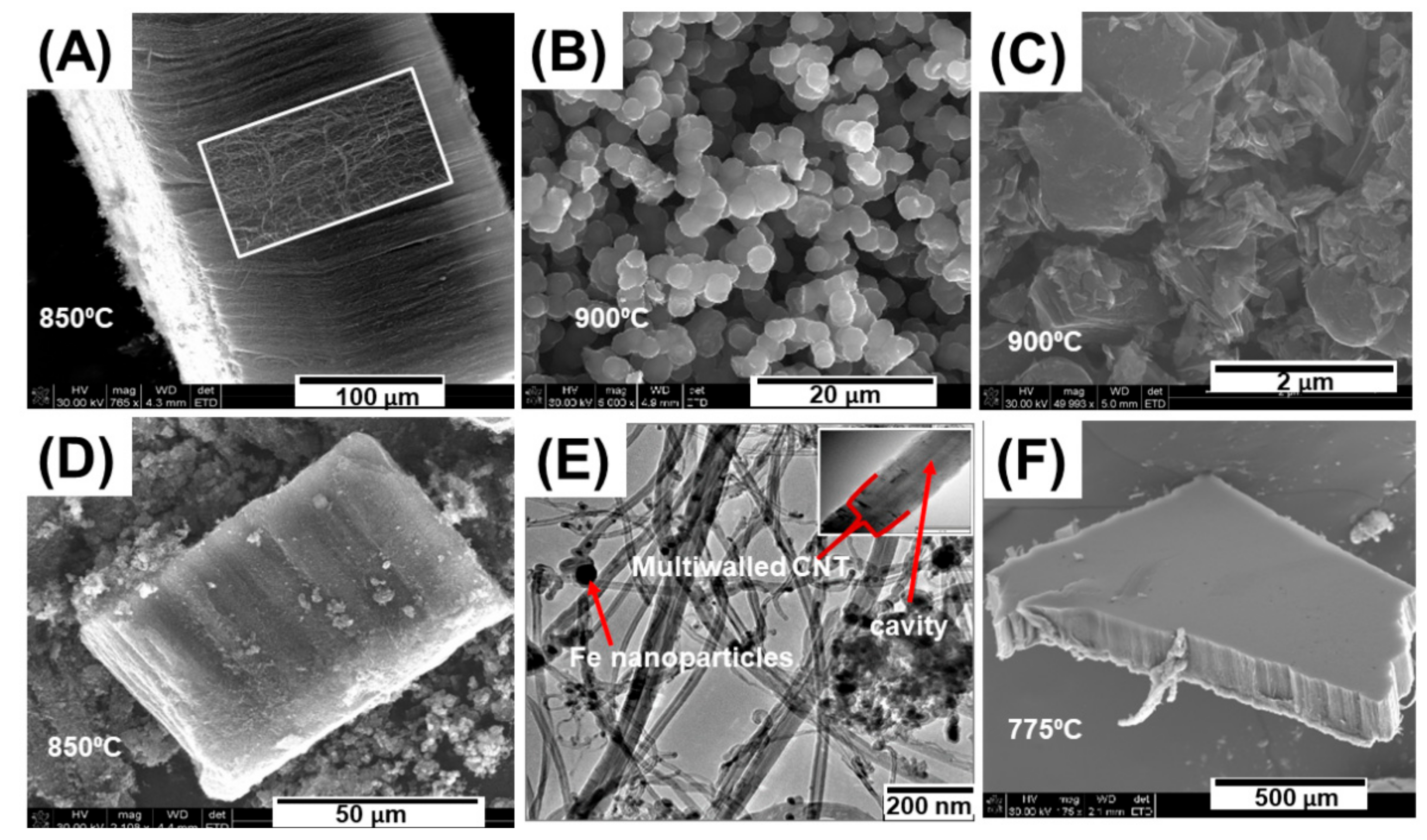
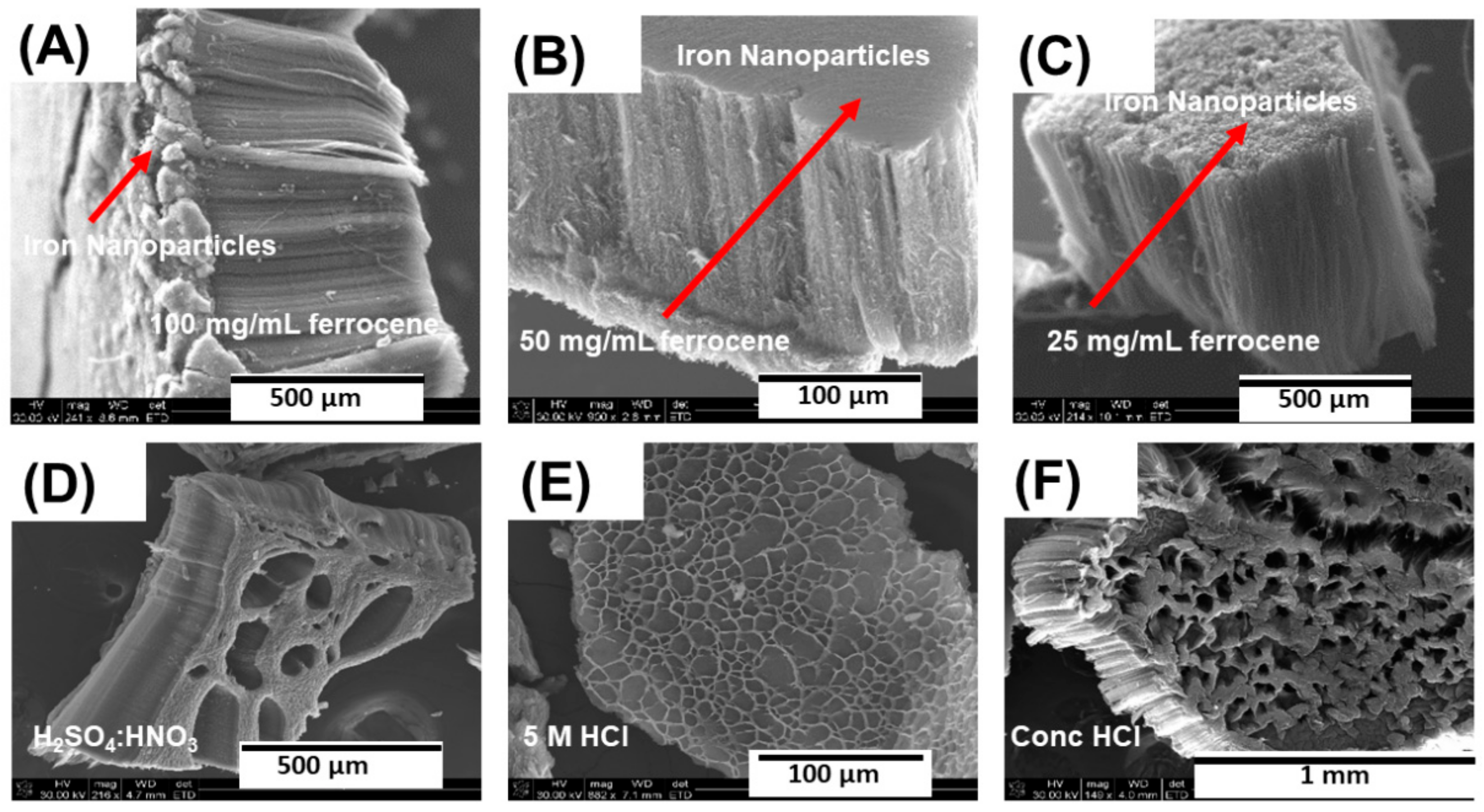
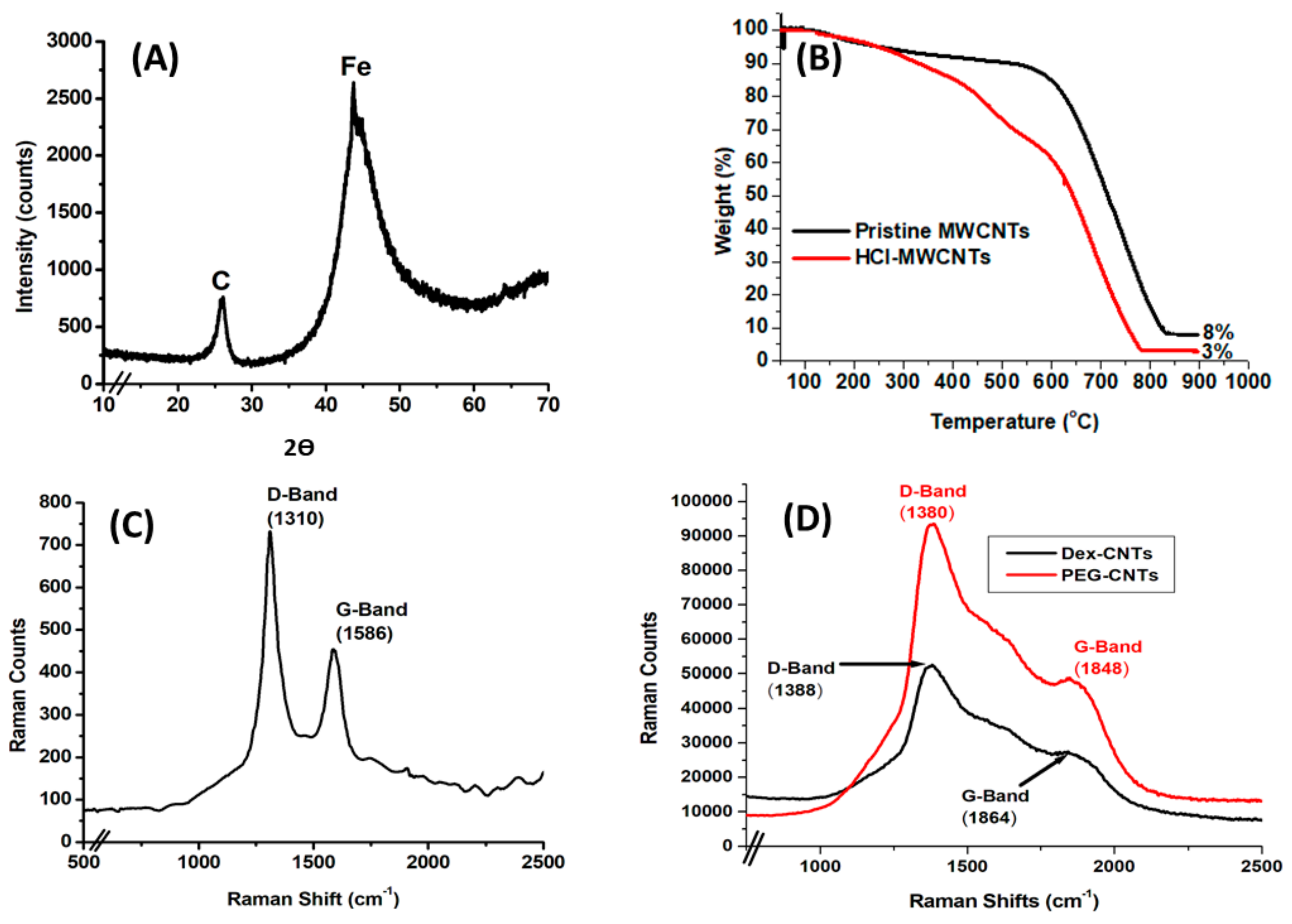
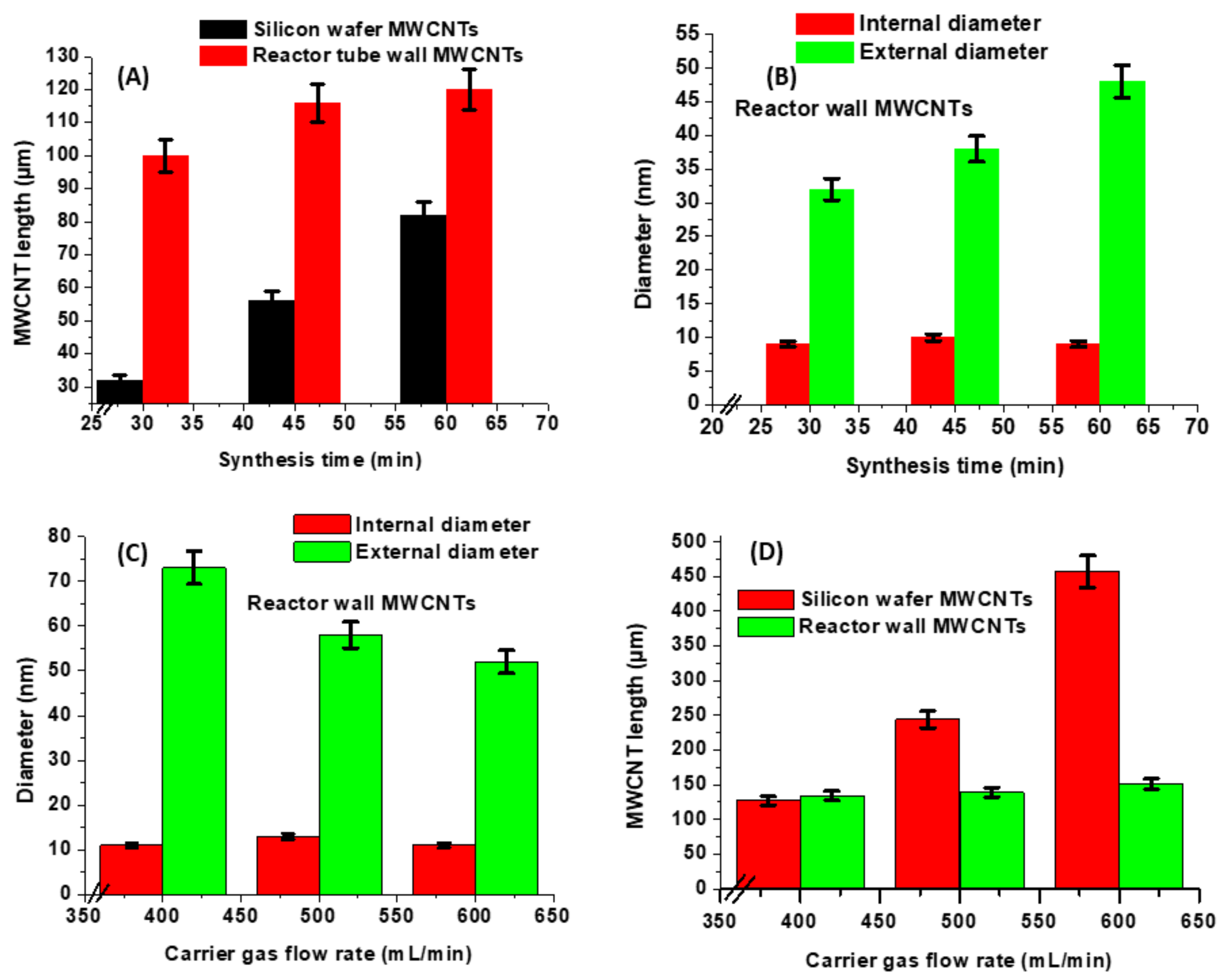
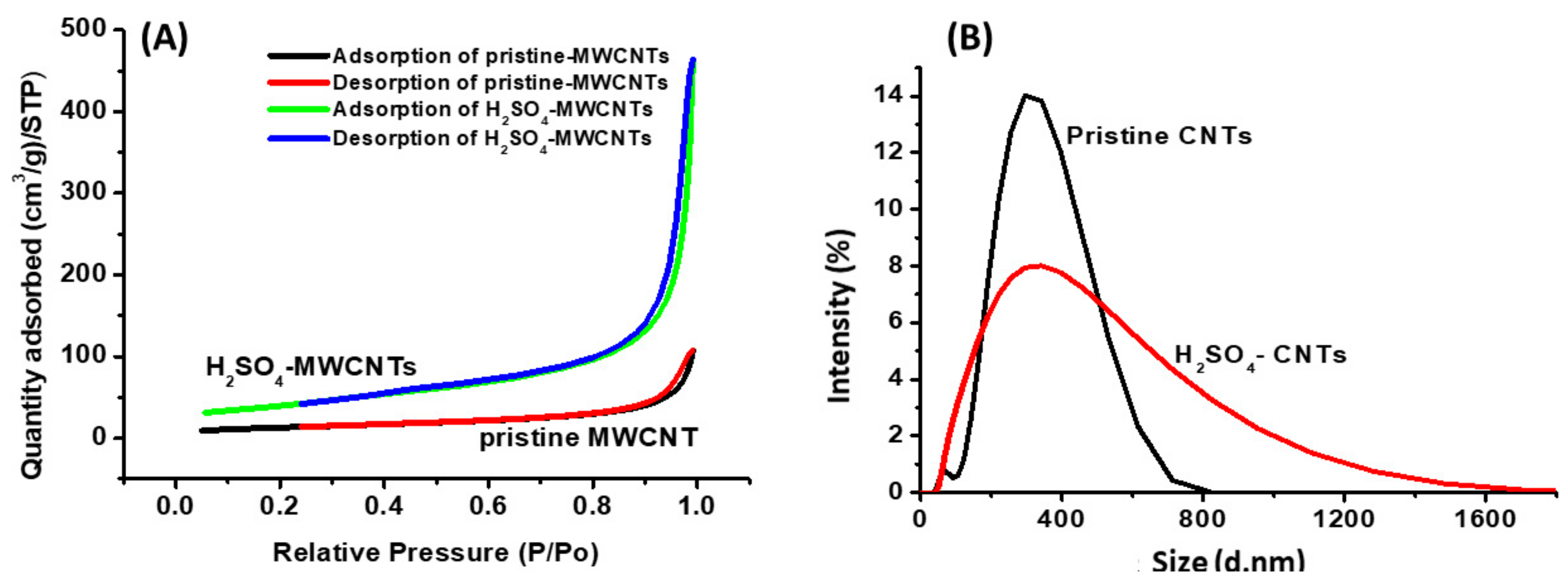
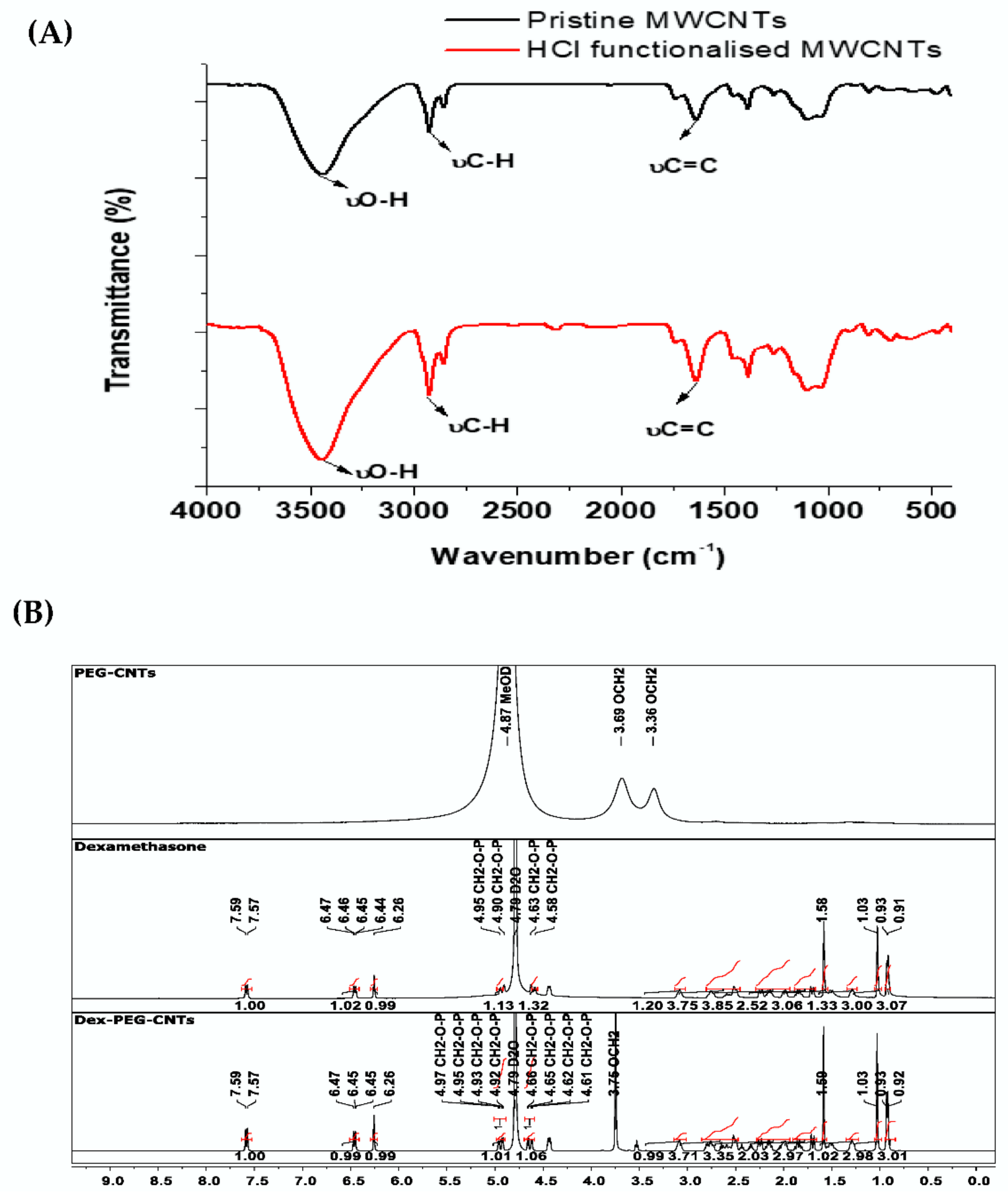
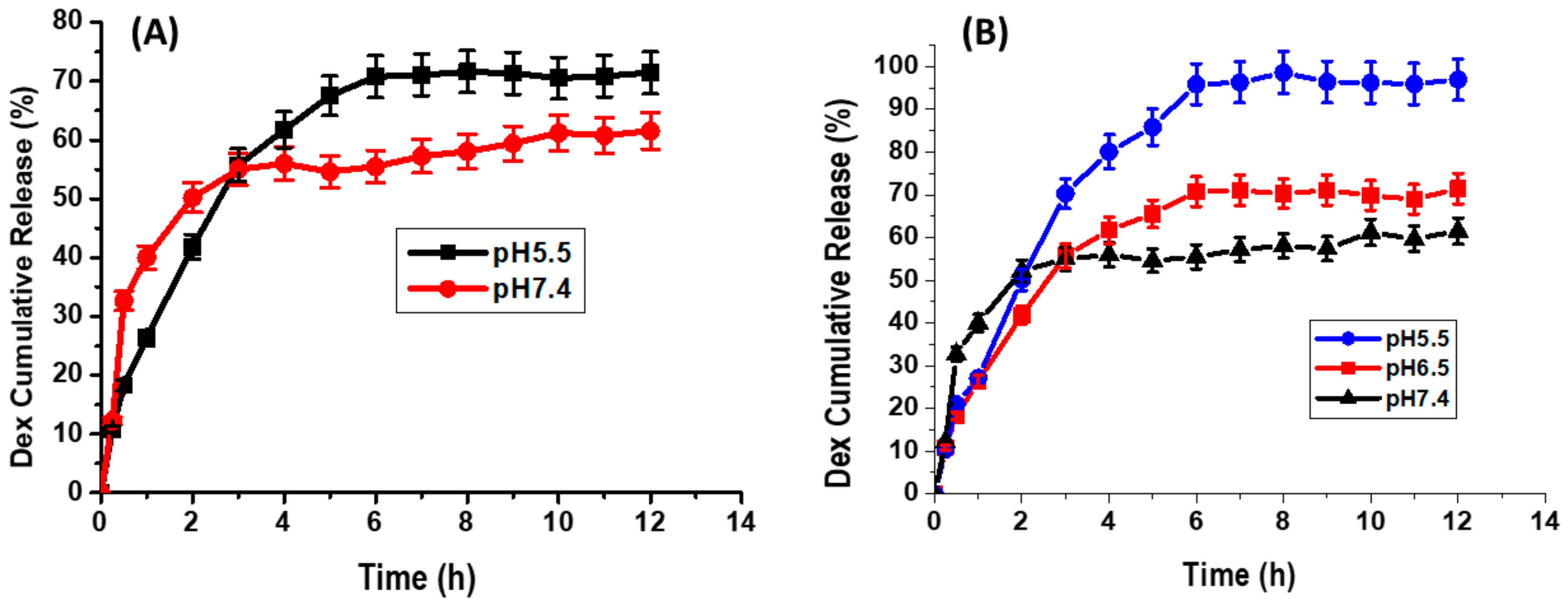

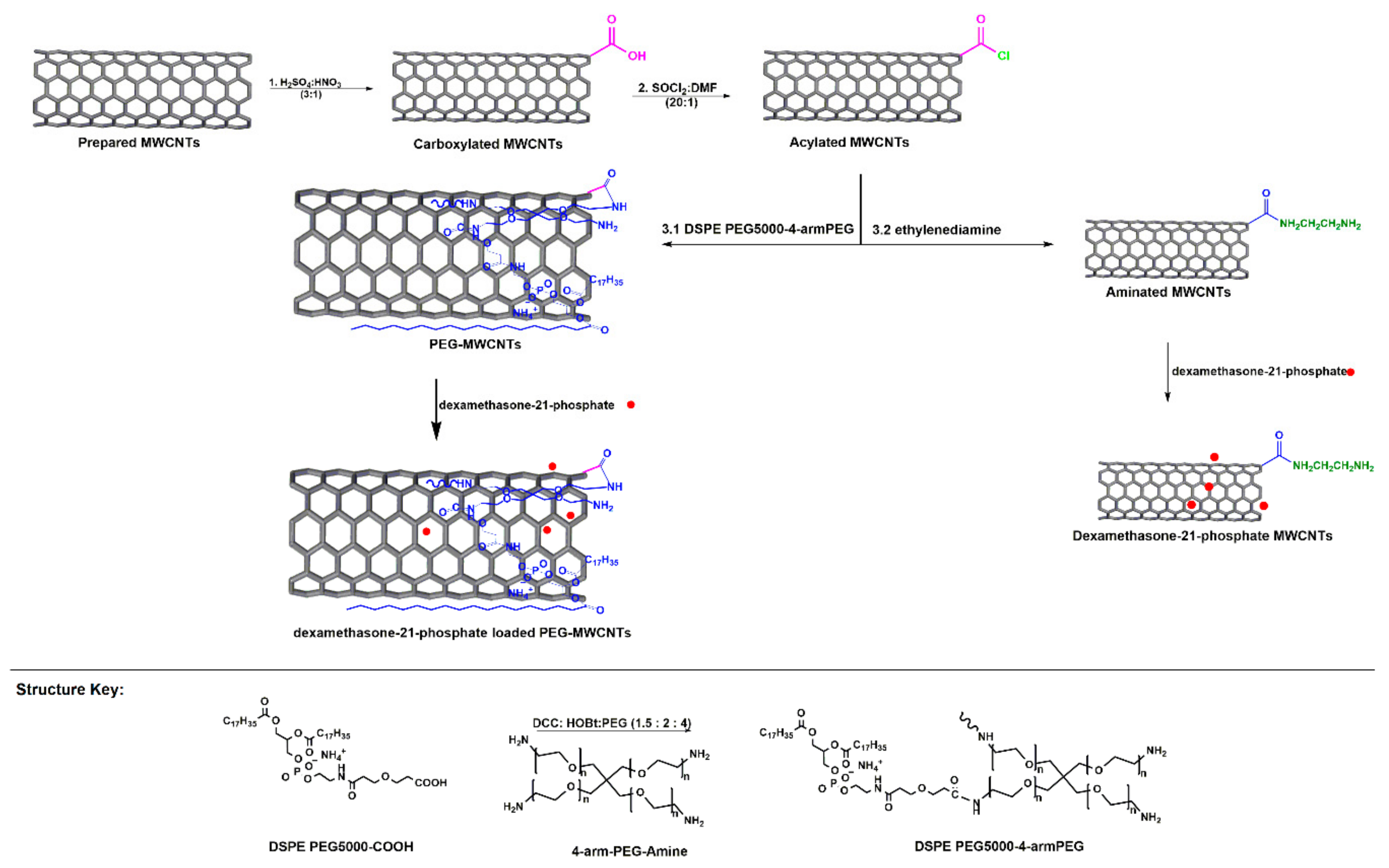
| Catalyst | Location | Mass before Run (g) | Mass after Run (g) | Final Mass (g) | Total Mass (g) | Yield % |
|---|---|---|---|---|---|---|
| Fe 25 mg/mL | Wafer | 0.1114 | 0.1222 | 0.0108 | 0.1879 | -- |
| QT | -- | 0.1771 | 0.1771 | |||
| Fe 25 mg/mLNi 1.25 mg/mL | Wafer | 0.1278 | 0.1282 | 0.0004 | 0.3312 | 43.27 |
| QT | - | 0.3312 | 0.3312 | |||
| Fe 25 mg/mLCo 1.25 mg/mL | Wafer | 0.0933 | 0.0935 | 0.0002 | 0.5994 | 68.65 |
| QT | -- | 0.5992 | 0.5992 | |||
| Fe 25 mg/mLCo 1.25 mg/mLNi 1.25 mg/mL | Wafer | 0.0435 | 0.0454 | 0.0019 | 0.2733 | 31.25 |
| QT | -- | 0.2714 | 0.2714 | |||
| Fe 50 mg/mLCo 2.5mg/mLNi 2.5 mg/mL | Wafer | 0.1476 | 0.1481 | 0.0005 | 0.5097 | 63.14 |
| QT | -- | 0.5092 | 0.5092 |
| Type | BET Surface Area (m2/g) | Pore Size (nm) | Pore Volume (m3/g) |
|---|---|---|---|
| Pristine MWCNTs | 47.1563 | 13.08973 | 0.154316 |
| 5 M HCl-MWCNTs | 144.0962 | 18.08957 | 0.651660 |
| % Increase | 67.27 | 27.64 | 76.32 |
© 2018 by the authors. Licensee MDPI, Basel, Switzerland. This article is an open access article distributed under the terms and conditions of the Creative Commons Attribution (CC BY) license (http://creativecommons.org/licenses/by/4.0/).
Share and Cite
Komane, P.P.; Kumar, P.; Marimuthu, T.; Toit, L.C.d.; Kondiah, P.P.D.; Choonara, Y.E.; Pillay, V. Dexamethasone-Loaded, PEGylated, Vertically Aligned, Multiwalled Carbon Nanotubes for Potential Ischemic Stroke Intervention. Molecules 2018, 23, 1406. https://doi.org/10.3390/molecules23061406
Komane PP, Kumar P, Marimuthu T, Toit LCd, Kondiah PPD, Choonara YE, Pillay V. Dexamethasone-Loaded, PEGylated, Vertically Aligned, Multiwalled Carbon Nanotubes for Potential Ischemic Stroke Intervention. Molecules. 2018; 23(6):1406. https://doi.org/10.3390/molecules23061406
Chicago/Turabian StyleKomane, Patrick P., Pradeep Kumar, Thashree Marimuthu, Lisa C. du Toit, Pierre P. D. Kondiah, Yahya E. Choonara, and Viness Pillay. 2018. "Dexamethasone-Loaded, PEGylated, Vertically Aligned, Multiwalled Carbon Nanotubes for Potential Ischemic Stroke Intervention" Molecules 23, no. 6: 1406. https://doi.org/10.3390/molecules23061406
APA StyleKomane, P. P., Kumar, P., Marimuthu, T., Toit, L. C. d., Kondiah, P. P. D., Choonara, Y. E., & Pillay, V. (2018). Dexamethasone-Loaded, PEGylated, Vertically Aligned, Multiwalled Carbon Nanotubes for Potential Ischemic Stroke Intervention. Molecules, 23(6), 1406. https://doi.org/10.3390/molecules23061406







